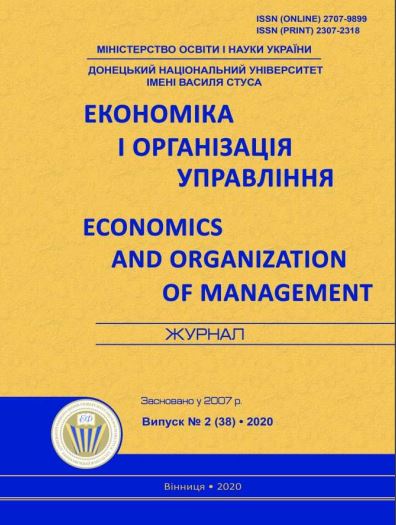Joint stock capital management societies in the conditions of growth of intangible assets
DOI:
https://doi.org/10.31558/2307-2318.2020.2.3Keywords:
joint-stock company (JSC); enterprise value; current value; securities; intangible assetsAbstract
The article provides an assessment of the value of an enterprise in the context of an increase in the capitalization of the country's economy as the most important factor in strengthening competitive advantages on the example of the market of steel and iron casting for car building. It has been substantiated that the valuation of the enterprise is limited by the poor development of the domestic securities market, since the growth potential of the current value of shares is not taken into account, depending on the perception of the value of the brand and related intangible assets. It is generalized that the existing directions of effective assessment of the cost of the production potential of an enterprise when organizing the release of new products, subject to investment in modern technologies and technological solutions, are not able to provide a significant inflow of investments in the required volume, especially in intangible assets.
The analysis of the factors of formation of the potential for growth and the current value of the enterprise for shareholders is carried out according to two main elements: the present value of future cash flows in a specific forecasting period; long-term value of shares depending on the perception of the value of brands and related intangible assets, that is, research and development work, concluded contracts, brand name, new technologies and technological solutions, and the like. The main factors of the strategic prospects for building up intellectual capital in conjunction with an increase in product sales, it is advisable to include the growth of market capitalization. The key factors in the growth of market capitalization are technologies and technological solutions of innovative types of products: steel ingots, which are used to produce pipe billets used in power units and nuclear power plants; rear axle housing of KrAZ heavy-duty vehicles; automatic couplings designed for the transmission of shock and traction forces devices for placing the mechanism, together with which the coupling and uncoupling of the cars is carried out; steel castings for pipeline fittings; draft gears are designed to mitigate longitudinal forces transmitted through the automatic coupler to the frame and other parts of the car.
References
Мних О. Б. Ідентифікація та оцінка чинників формування вартості акціонерних товариств: теоретико-прикладні аспекти. Вісник Національного університету «Львівська політехніка». Серія «Логістика». 2007. № 580. С. 81–97.
Голіков В. І. Розвиток корпоратизму і корпоративних відносин в економіці України. Київ: Інститут економічного прогнозування. 2002. 304 с.
Назарова Г. В. Організаційні структури управління корпораціями: монографія. Харків: ВД «ІНЖЕК», 2004. 420 с.
Келлер Кевин Лейн. Стратегический брэнд-менеджмент: создание, оценка и управление марочным капиталом; пер. с англ. Москва: Издательский дом «Вильямс», 2005. 704 с.
Поважный А. С. Проблемы управления и организации деятельности акционерных обществ в Украине. Донецк: ДонГАУ, 2000. 172 с.
Петруня Ю. Є. Акціонерні товариства в Україні: проблеми емітентів та інвесторів. Дніпропетровськ: ДАУБП, 2000. 100 с.
Офіційний сайт ПАТ «Кременчуцький сталеливарний завод». URL: http://steel.pl.ua/MyKSZ/admin/main.php (дата звернення: 25.08.2020)
Дорожкіна Г. М. Прогностичне моделювання організації виробництва нових видів продукції. Економіка: проблеми теорії і практики. 2004. №189. Т. 3. С. 799–807.
Корпоративне управління в Україні в сучасних умовах: могонграфія / за заг. ред. І. Розпутенка та Б. Лессера. Київ: К.І.С., 2004. 306 с.
Сірко А. Корпоративна власність у транзитивній економіці. Економіка України. 2002. №4. С. 57–64.

